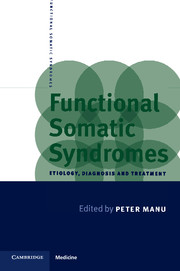Book contents
- Frontmatter
- Contents
- List of contributors
- Preface
- 1 Definition and Etiological Theories
- 2 Chronic Fatigue Syndrome
- 3 Fibromyalgia Syndrome
- 4 Irritable Bowel Syndrome
- 5 Premenstrual Syndrome
- 6 Interstitial Cystitis
- 7 Temporomandibular Disorders
- 8 Chest Pain Syndromes
- 9 Repetitive Strain Injury
- 10 Multiple Chemical Sensitivities
- 11 Psychopharmacology of Functional Somatic Syndromes
- 12 Psychotherapy of Functional Somatic Syndromes
- 13 Determination Of Disability Claimed By Patients With Functional Somatic Syndromes
- 14 Functional Somatic Syndromes: Exploring Common Denominators
- Index
10 - Multiple Chemical Sensitivities
Published online by Cambridge University Press: 08 January 2010
- Frontmatter
- Contents
- List of contributors
- Preface
- 1 Definition and Etiological Theories
- 2 Chronic Fatigue Syndrome
- 3 Fibromyalgia Syndrome
- 4 Irritable Bowel Syndrome
- 5 Premenstrual Syndrome
- 6 Interstitial Cystitis
- 7 Temporomandibular Disorders
- 8 Chest Pain Syndromes
- 9 Repetitive Strain Injury
- 10 Multiple Chemical Sensitivities
- 11 Psychopharmacology of Functional Somatic Syndromes
- 12 Psychotherapy of Functional Somatic Syndromes
- 13 Determination Of Disability Claimed By Patients With Functional Somatic Syndromes
- 14 Functional Somatic Syndromes: Exploring Common Denominators
- Index
Summary
The concept of an illness with subjective wide-ranging symptoms triggered by exposure to numerous environmental chemicals, called multiple chemical sensitivities (MCS), has existed for at least 40 years, but it remains controversial. MCS bears a close resemblance to other current syndromes such as the chronic fatigue syndrome, myalgic encephalomyelitis and various chronic pain syndromes. These are also typically multisymptomatic, although they have a sentinel symptom – fatigue, pain or musculoskeletal discomfort – and there is no connection to environmental exposures.
MCS has also been compared with somatoform illness because the numerous somatic symptoms suggest physical illness involving many different body organs and systems, but without objective evidence of disease.
MCS may be confused with allergic, toxic, irritant or even infectious diseases because of its presumed association with the environment. Allergic diseases are characterized by inflammation and organ dysfunction usually localized to a particular tissue such as the nasal or bronchial mucosa or the skin, and established testing procedures can identify the specific immunological sensitivities. Toxic and irritant diseases are reliably dose dependent with objective evidence of pathology consistent with the chemical and/or physical properties of the environmental chemical and route of exposure. Building-related illnesses should also not be confused with MCS. Occupational asthma and hypersensitivity pneumonitis are allergic diseases in which wellvalidated tests determine the specific allergen and the immunological sensitivity of the patient.
Keywords
- Type
- Chapter
- Information
- Functional Somatic SyndromesEtiology, Diagnosis and Treatment, pp. 202 - 218Publisher: Cambridge University PressPrint publication year: 1998



